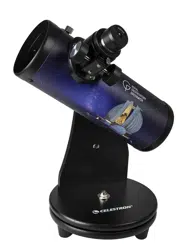Loading ...
Loading ...
Loading ...

16 | ENGLISH
Nebulae
Nebulae are large clouds of ionized gas or dust that lie in interstellar space.
They can be classified into three basic categories:
Emission Nebula - These nebulae are rich in HII (pronounced H2), or ionized hydrogen. The ionized hydrogen glows
as a result of high-energy photons emitted from a nearby massive star. Emission nebulae usually contain star forming
regions where the gas clouds coalesce and new stars are born. They can also be found at the other end of a star’s life
cycle, when a massive dying star sheds it outer layer into space. The gas expands into a spherical cloud and is ionized
by the star’s exposed core. This special type of emission nebula is called a planetary nebula.
Reflection Nebula - These nebulae are often rich in HII, but do not give off light of their own. Instead, these nebulae
reflect the light from nearby stars that are not massive enough to excite the ionized gas.
Dark Nebula - These nebulae are clouds of dust and HII, but are not illuminated by close stars. They are only seen
because they block the light from stars behind them, creating dark areas in an otherwise bright star field.
Many of these nebulae are very large objects and under dark skies, you may trace them over a sizable percentage of
the view in a low power eyepiece. Planetary nebulae are usually small in diameter and will look better using moderate
to high power.
Observing the Orion Nebula
The Orion Nebula is a “stellar nursery,” a large diffuse HII
region where new stars are forming. It is extremely easy to
locate, visible to the naked eye as a small fuzzy patch in the
constellation of Orion. The nebula appears as a jewel in the
sword that hangs from three stars of Orion’s belt. This is one
deep-sky object that has very high surface brightness and
even looks good from suburban skies, though dark skies will
show significantly more detail. Use low magnification for this
object as it is big and you’ll want to see it against the dark
backdrop of the surrounding sky. The nebula appears as a faint
greenish glow in the eyepiece, with a brighter center portion
with a dark gulf on one side. The glow of this emission nebula
comes from the star cluster at the center. The four brightest stars in the cluster are known as the Trapezium for the
trapezoidal shape they form. Astronomers know that more stars are being formed in this nebula, but they are shrouded
from view by the gas and dust.
Observing the Lagoon Nebula
The Lagoon Nebula is another excellent example of an HII star-forming region. Under dark skies, this nebula is just visible
to the naked eye in the constellation Sagittarius. In a low power eyepiece, the greenish-gray nebula appears as a star
cluster surrounded by an oval shaped glow with a brighter core. This nebula contains a number of Bok globules, dark
clouds of gas condensing into new stars.
Observing the Ring Nebula
The Ring Nebula is a planetary nebula that was created when a red giant star, near the end of its life, blew off its outer shell,
leaving behind an exposed core that would evolve to a white dwarf star. It is located in the constellation Lyra, between the
two naked eye stars representing the base of the lyre and only about 6 degrees from Vega, the second brightest star in
the northern hemisphere. The nebula looks like a small blue smoke-ring in lower magnifications. Using magnifications of
100x or more will show a bright edge with a noticeably darker center.
PRACTICE WHAT YOU HAVE LEARNED: OBSERVING NEBULAE
Loading ...
Loading ...
